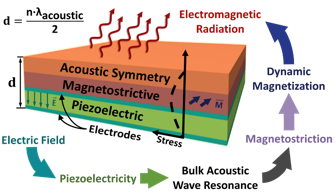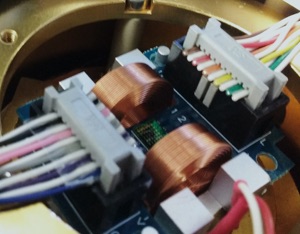
Research
The research interests of the Sensors and Technology Lab lie broadly in the area of nano/microelectromechanical systems (N/MEMS), specifically in areas that reach into other disciplines, such as physics and medicine. The current research involves fundamental limitations of N/MEMS, N/MEMS for free electron lasers, N/MEMS for scientific and medical tools, and the interface of microsystems with chemistry and biology.
There has been a surge of interest in the field of multiferroic devices, which enable control of magnetism using voltage instead of the traditional method of current-based control of magnetism. This interest is spurred partly by the emergence of electric-field driven, stain-mediated magnetoelectric (ME) coupling in ferroelectric and ferromagnetic materials. This strain-mediated ME coupling is tunable by an applied electric field, at the core of designing new multiferroic devices, such as miniature antennas, nanoscale memories, magnetic field sensors, and motors. Our group has focused on understanding and utilizing the dynamics of magnetic domain of strain-mediated multiferroic materials, from both the modeling and experimental perspectives, with the goal of realizing a submicron multiferroic motor for a range of applications. Working jointly with researchers from the TANMS research center, we characterize the fundamental physical properties of our devices using the beamlines at the Advanced Light Source, Lawrence Berkeley National Laboratory. Collaborating with researchers from biomedical engineering, we work on navigating and precisely controlling magnetically-tagged cells and particles using these motor arrays in a microfluidic environment for localized capturing and sorting purposes.
Compact Multiferroic Cell and Particle Sorting Platforms
Miniature free electron lasers
High brightness light sources, particularly free electron lasers, are the most powerful microscopes in the world. While they produce a light pulses with an unrivaled combination of high brightness, short pulse duration, and high photon energy, they are typically 100s of m long or more and upwards of $1B USD to build. To complement these facilities, we are partnering with our colleagues in UCLA Physics and Astronomy to build a free electron laser that can fit in a university laboratory. To accomplish this, we are microfabricating miniature electromagnet arrays to focus and steer relativistic electron beams, from which high energy light is extracted.
Micro- to Millimeter Scale Magnetic Shielding
Because of its minimally invasive techniques and precise micro-controllable movement, robotic surgical system sheds light on the new paradigm of surgery. However, despite its advantages, its usage is limited by an absence of tactile feedback. We are seeking for a way to measure compressive forces on a surgical grasper and to give this information back to surgeons with elaborate electrical circuits.
Design Optimization for MEMS




Design of microsystems that couple many physical realms is a complex proposition, but it is made feasibly by utilizing evolutionary algorithms. As one example, we are optimizing resonators to minimize thermoelastic damping, which could lead to lower noise oscillators, higher resolution gyroscopes, or improved resonant sensors. Holes in the beam disrupt heat flow and change the coupling between the mechanical and thermal domains. Complex multiphysics solvers are becoming more accurate and more practical and provide useful tools to explore novel designs. With these new modeling capabilities, and new high performance computing capabilities, design optimization with complicated coupled physics is becoming practical. MEMS design, which historically has relied on a trial and error approach can benefit greatly from these new design optimization techniques.




Tactile Feedback in Robotic Surgery
Recent advances in atom traps and atomic interferometry have led to chip scale atomic clocks making high precision timing and navigation devices more accessible. Further miniaturization is limited by stray fields from other systems introducing drift and increasing noise. Leveraging our expertise in electroplating thick, high permeability Permalloy over sharp topologies, we have demonstrated a process to produce conformal magnetic shielding around arbitrary geometries. Furthermore, shielding scales multiplicatively with successive layers, meaning laminations provide superior shielding compared to a single shield with the same total thickness. Microfabrication can therefore reduce size and weight by two orders of magnitude and amplify the shielding factor for appropriate characteristic lengths. Thus, we are also utilizing batch processing techniques to enclose miniature magnetic sources.


3D Magnetic Printing
Additive manufacturing has provided a new methodology of fabricating structures with complicated shapes; however, despite efforts up to date, the materials selection is still very limited. A class of smart materials known as magnetorheological elastomer, composites of polymer and magnetic materials, has been fabricated via traditional techniques and only recently additive manufacturing. If the concept of a printable, magnetic material is taken further, one possibility is to change the orientation of magnetization in-situ. This idea is made possible by deployment of hard magnetic, namely, barium and strontium hexaferrite, particles. These hexaferrites have strong magnetocrysalline anisotropy. Due to their large internal anisotropy field, the particles of these materials tend to rotate to the field direction instead of changing magnetization direction while experiencing an external magnetic field (less than the anisotropy field). We have developed methods of fabricating composites of high hexaferrite concentration (up to 50% by volume). The magnetic properties of the composites meet the expectation of mixtures with fractional magnetic material (fig.1). Rotation of hexaferrite particles in polymer matrix and thus magnetic anisotropy has been demonstrated in composites of different concentration (fig. 2). The realization of such capabilities makes direct printing of magnetic components that require anisotropic magnetization possible.


3D Printed Microfluidics
Soft lithography of polydimethylsiloxane (PDMS) gives rise to the majority of microfluidic devices in academia. However, conventional MEMS fabrication processes cannot completely address this growing field. We've begun to develop three-dimensionally printed (3DP) molds for rapid fabrication of complex and arbitrary microchannel geometries. These molds are printed directly from computer-aided design (CAD) files, making rapid prototyping of microfluidic devices possible in hours. These 3D printed structures enable precise control of various device geometries, such as the channel profile and variable channel heights in a single device.

(left) Variable channel diameter, double-helix structure. (A) Computer-aided deign (CAD) schematic used to generate 3DP mold. (B) PDMS scaffold after removal of 3DP mold. (C) Single channel with colored water. (D) Both channels filled.
(right) Soft pneumatic actuators with hierarchical structure, built from 3D-printed molds.

Multiferroic coupling using quasi-static mechanics is well established and has been successful in the development of devices such as magnetoelectric memory, nanoscale motors, and tunable radio frequency (RF) devices. However, the physics behind dynamic multiferroic coupling using mechanical waves has not been thoroughly investigated. Since mechanical waves travel much slower than the electromagnetic waves, taking advantage of them allows for the miniaturization of RF components up to a factor of 100,000 (for reference, that's like shrinking a football field down to the size of a flea). In collaboration with groups across several universities and countries, we conduct research on the interaction of mechanical oscillations with multiferroics and apply our findings to the design of miniature RF devices. Our main goal is to use this technology to develop small-scale high efficiency multiferroic antennas that will enable a new, and previously unreachable, generation of miniaturized wireless systems.
Radio Frequency Multiferroics


